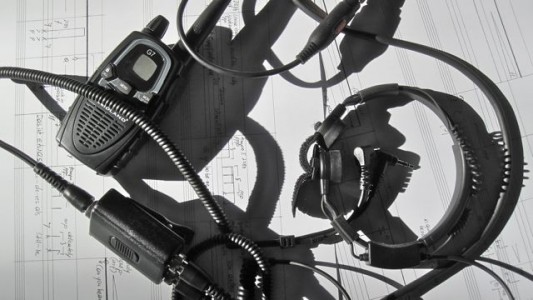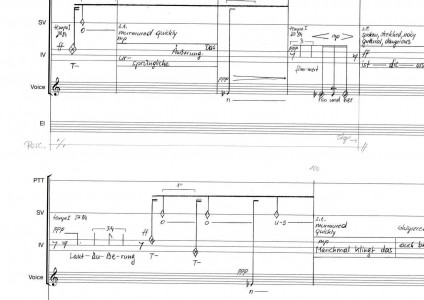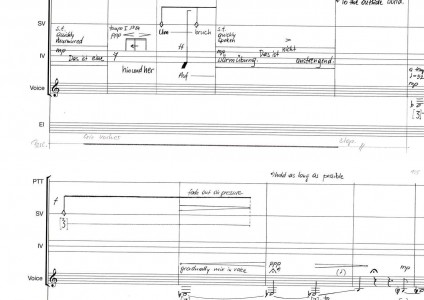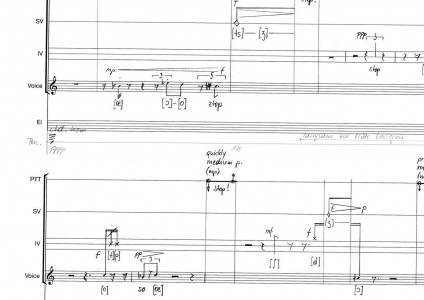LIP OF THE REAL (2012)
for mezzo-soprano,
throat microphone and PTT-button,
live-electronics and percussion.
Total length: ca. 34 min.
Texts by:
Margret Kreidl (in German)
Pia Palme (in English)
Anne Waldman (in English)
Libretto compilated by Pia Palme.
>>> click here read the complete Libretto
The piece was live recorded in March 2012: Lore Lixenberg performing the voice-part at Alte Schmiede Vienna with Bernd Thurner, percussion, Pia Palme, live-electronics (4-channel) and Alfred Reiter, sound-design.
About the piece
The title is a quotation from Anne Waldman’s new book IOVIS. It is a subtitle of a part, in which Anne Waldman describes meeting an old colleague of hers. Touching one’s lips to reality? She also mentions that her poetry-students are not allowed to use a combination like this: tangible-put-with-abstraction joined by preposition “of” – and finally raises the rhetorical question: “Does she get away with it?”
LIP OF THE REAL is basically a contemporary solo for voice. The electronic part serves as a compositional extension of the vocalist, creating an audible space around the voice, which maps fictitious mind-activity of the vocalist. Bass drum and some carefully selected percussion parts are added, for sound and context.
The idea and basic concept for this piece originates from three pivotal points.
One is the wish to create a compositional layout which would audibly and visually express structural movements of human (more precisely: my) mind how I perceive it. I consider these movements as a biotic process: fluid layers of consciousness and awareness on top of of each other, my awareness jumping from one layer to another as the focus of attention shifts. Sometimes mind seems more resting in one level/layer, at other times quickly shifting focus (multitasking). It resembles a flexible process involving vivid movement and energy, and textural changes of what goes on in mind.
Corresponding to four layers of mind activity, I chose four staves for the voice-part. Each one describes a different state of consciousness, a different world. It is not a system of four staves in the usual sense, because they do not share the same tempo. Every stave has a different tempo and textural context.
On the very top of the system is the “watching” activity, the fact that mind is reflecting on itself, is watching itself. The ability of mind which seems to monitor every other activity, and the resulting ongoing commentary. The text for this stave was written by myself, based on my own perceptions.
This text is spoken with closed mouth, as it runs completely inside mind. It is monitored by a throat microphone. This gadget was originally developed for military use: more specifically for clear communication in loud surroundings, such as combat or inside a tank. It uses electret membranes to pick up sound, and signals are transmitted via radio between persons.
Discovering this microphone, buying it, talking to specialists in shops about what I plan to do with the microphone and radio-transmitter was another interesting story, sparking ideas. (Throat microphones are currently also used by gaming experts or paintball-fighters.)
The PTT button needs to be pushed for communication; here, the vocalist has to push it to communicate with the electronics and the audience. Inner sounds are picked up and transmitted to my live-electronic setup. I further work with the sound, using various electronic means (computer-programs and analogue machines). The transformation of the vocalist’s sounds makes up an electronic ‘basso continuo’.
Second comes the Inner Voice, which is the most diffuse, a mere stream of energy uttering single words like rough ideas popping up from deep down. The main timbre here is a highly energized, intense whispering, lots of air pushed through with the whisper, so that the stream of air becomes audible.
The Secret Voice is the bridge between inner and outer activity. It is more detailed and skillful, uses different pitches and sometimes accurate notation. It contains a lot of text and words.
The text used in IV and SV was written by Austrian author Margret Kreid reflecting on her experience of taking singing lessons with a professional singer (Ute Wassermann, by the way). She composed this text about what she perceived during these singing lessons. A lot of is perceptions and emotional content connected with voice, and the use of her own voice.
On the bottom of the system (down to earth) is the Voice in its more traditional form. Notated accurately in a five-line system, this part uses actual singing.
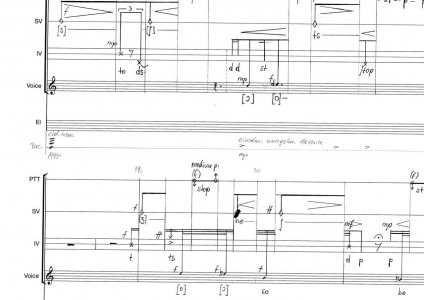
Altogether, the three bottom staves for the voice carry music spaced out in time, as if things surfacing from a deep lake at various intervals. This leads to the third idea behind this piece: I wanted to avoid writing longer periods of precisely defined rests, which would imply counting (of beats, or seconds) for the vocalist. The natural flow of mind to me does not imply ongoing counting. But somehow, the sense of spacing out sounds in time needs to be facilitated. I decided to use the inner monologue, the commentary, as a timer for the other expressions. Instead of counting rests, the vocalist has to recite pieces of texts with closed mouth. When a text is finished, she moves on.
Through this setting I not only achieve an “organic” way of dealing with times and space, I also gain material for further live-electronic sounds. The material from the inner monologue is used for manipulation with programs (Ableton) and analogue machines (ring-modulators, delays, sequencer).
I further added percussion, sparingly: bass drum, three chinese gongs (app. f, #f, g) and two singing bowls. The drum is used in several ways, also as a resonator for bowls and gongs placed on top. The drum was chosen not only for its sound qualities but also because of its social contexts: as an instrument used to accompany the proclamation of important news in former times, because of its connection to warfare and to dance-music (techno!).
❏
